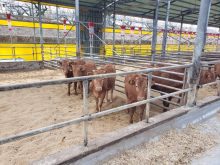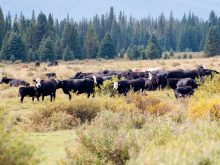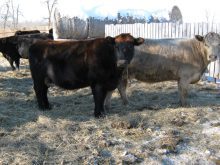As a rancher and a senior forage specialist with Union Forage, Graeme Finn has spent much of his time looking into how feeding cattle affects their fertility. He says it was something drilled into him as a child in Australia.
“My grandmother always said, ‘Feed the cattle good at breeding time,’ because that’s when you get your best fertility with the best-quality forages,” Finn says. “It’s kind of been educated from when we were just kids that you leave your best pastures for your breeding season.”
Read Also

Harvest wraps up and fall work begins
At the Eppich famly ranch in western Saskatchewan, the fall harvest was successful with few breakdowns, cows and calves have been sorted and a new tractor has arrived
Finn says if Canadian producers can learn more about grazing for fertility with a high-legume and grass-forage stand in the pastures, it will improve their operations and their success that much more. That’s especially as more drought conditions show up on the Prairies.
Here are six areas to keep an eye on to help improve cow fertility.
Body condition score
Kristen Ritson-Bennett is a ruminant nutritionist and managing partner at Blue Rock Animal Nutrition in Alberta. She says the biggest indicator of how well a producer’s nutrition program is doing is based on the cow’s body condition score (BCS).
“That’s going to be directly related to whether or not there’s enough protein and energy in the ration,” she says.
According to the Beef Cattle Research Council (BCRC), cows with an ideal BCS rebreed up to 30 days sooner than cows who don’t meet the ideal score, which allows more cows to calve in the first 21-day cycle.
“One thing that I talk to my producers about all the time is that body condition score at calving is your greatest predictor for conception the next year,” Ritson-Bennett says. “Because if she doesn’t fall pregnant, you aren’t going to have a calf cheque.”
What to feed
Dr. Bart Lardner is a professor at the University of Saskatchewan in the College of Agriculture and Bioresources, where they have researched feeding for fertility. He says it’s important producers pay attention to what the animal is eating.
“That animal has a requirement for nutrients every day,” Lardner says. “So specifically, which ones are important: energy, protein and minerals and vitamins. And so if those are not in adequate levels or nutrient density, then all of a sudden we do run into issues in terms of fertility.”
Finn says it’s important to feed the cattle high-protein plants that will increase their energy. That, he adds, includes “I think having a minimum of three legumes in your pasture blend and then high-quality pasture grasses.”
Lardner agrees legumes are a good thing. Not only do they provide the cattle with nutrients, but they also enhance a pasture since they are higher in quality than some other grass species because of their greater leaf-to-stem ratio. Legumes also have higher protein than other plant species often found in a pasture and will put nitrogen back in the soil.
Mineral blends
Mineral blends are used in a cow’s diet to maintain health and supplement minerals she doesn’t get in her regular diet.
However, mineral supplements are also very effective at improving a cow’s fertility. Manganese, copper and zinc are what Lardner calls the “fertility minerals.”
“All three are very involved in sperm production, and estrus cycling in female cattle, and so we need to make sure that there are adequate levels in that supplemental, granular trace mineral,” he says.
Despite these minerals being fertility minerals, Lardner says it’s important not to forget to add macro minerals, such as calcium and phosphorus.
Finn says finding the perfect blend of minerals specific for your cattle herd is an important factor in cattle fertility.
“You’ve got to have a mineral package designed for your pasture,” Finn says. “A lot of these mineral packages come off the shelf. They’re for Western Canada, but my pasture might be different from your pasture.”
Winter feeding
Feeding for fertility is easier in the summer when cattle are usually out on pastures, grazing. However, it could be hard for producers to know how to continue helping their herd’s fertility during the winter.
Lardner recommends vitamins — specifically, vitamin A, which is important for sperm production, and vitamin E. Since vitamin E is found in leafy green plants, it has to be supplemented in the winter.

“Make sure that you maybe give them that additional vitamin shot,” Lardner says. “We’ll see lower conception rate(s), see some weak calves and maybe early abortions with that vitamin A deficiency.”
Heat and management
Lardner says producers may have seen an effect on fertility during the drought years, which affected forages and the proteins the cattle consumed.
“Inadequate protein will certainly have a negative impact on the estrus cycle or the heat cycle of these females. They just won’t cycle,” he says. “Hence, they won’t get pregnant or ovulate for pregnancy.”
Ritson-Bennett echoes this. For example, in 2020, they saw “excessively high levels of heat in July” in herds bred in July. “And those bulls had no libido, they didn’t want to breed at all.”
A replacement heifer that doesn’t get enough energy in her feed will take longer to reach puberty compared to a female with a balanced ration. Male calves and bulls may experience suppressed libido and sperm production.
The fertility of cattle doesn’t depend entirely on nutrition, however. According to Ritson-Bennett, a variety of different management practices and issues could also have an impact on fertility. The cow-to-bull ratio, injuries and diseases can affect the fertility on your operation — as can heat stress, cold stress and predation.
“We definitely see lower reproductive success on those operations because those animals are on the move all the time, whether they’ve got wolves or bears around,” Ritson-Bennett says.
Testing
Because nutrition is such a big part of a cow’s fertility, it’s important to ensure it receives the proper amount of nutrients. That’s why both Ritson-Bennett and Lardner emphasize the importance of feed testing.
Ritson-Bennett says feed testing can identify many important things, such as shortfalls in protein or energy. As a result, producers will know before feeding if they need to invest in a concentrate (grain), if they need to bring in a protein supplement and what they need to do to balance minerals and vitamins.
Lardner says that although a feed test may seem like another thing on a long to-do list, it’s integral to an operation’s success and fertility.
“I know that times are tough,” he says. “And I know that input costs are going up. But what are some of the first things that producers will not put the money out for? That is certainly mineral supplementation. So yes, do a feed test.”
Lardner also recommends producers do a water test to ensure they are at the correct level of nitrates and sulphates.
For producers, knowing how to feed for fertility could help their herds in dry times.
As for spreading information on the importance of feeding for fertility, Finn hopes researchers in Canada will continue to help producers learn how to improve their operations.
“There’s knowledge out there, it’s just not getting out to producers as it should be,” he says. “So go and make friends with a researcher. They are good people and have helped me a lot.”
















